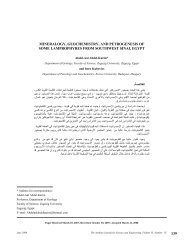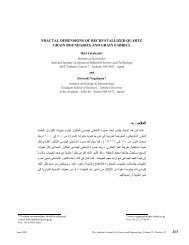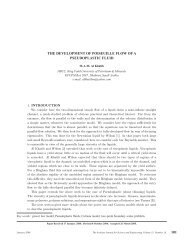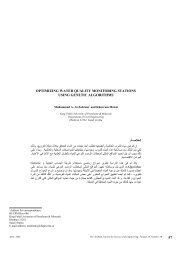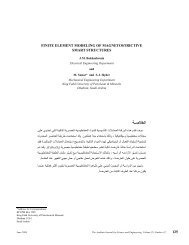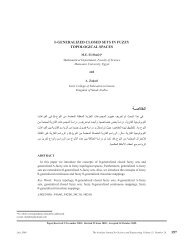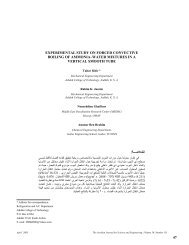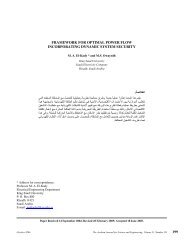lambert universal variable algorithm - Arabian Journal for Science ...
lambert universal variable algorithm - Arabian Journal for Science ...
lambert universal variable algorithm - Arabian Journal for Science ...
You also want an ePaper? Increase the reach of your titles
YUMPU automatically turns print PDFs into web optimized ePapers that Google loves.
3.2.2. Comments:<br />
• The initial limits of ψ are chosen to let the most common solutions converge.<br />
• For very eccentric (hyperbolic) orbits, one should expand the lower negative limit.<br />
M.A. Sharaf, A.N. Saad, and M.I. Nouh<br />
• To reduce the size of numbers involved in calculations, to make operations more mathematically stable, and also<br />
to speed up the <strong>algorithm</strong>, we used canonical units, such that, <strong>for</strong> the heliocentric system, length, mass, and time<br />
are expressed in astronomical units, solar masses, and days, respectively and the Gaussian gravitational constant<br />
given exactly [16] by<br />
k = k ⊗ = 0.01720209895 .<br />
While <strong>for</strong> the geocentric system, length, mass, and time are expressed in Earth’s radii, Earth’s masses, and<br />
minutes, respectively. By analogy with the heliocentric system, we shall assume a fundamental geocentric<br />
gravitational constant given by<br />
k = k ⊕ = 0.074366864 .<br />
In both systems the gravitational parameter µ = 1.<br />
3.3. Numerical Applications<br />
We used three Earth test bodies with position vectors r0 ≡ ( x0, y0, z 0)<br />
and r ≡ (x, y, z) listed in Table 1 together with<br />
the eccentricities e and their types. The position vectors are expressed in the geocentric canonical unit ER<br />
(ER = 6378.1363 km). Computational <strong>algorithm</strong> 3 is then applied <strong>for</strong> each orbit with µ = 1, Tol = 10 –7 , M = 50, tm = 1<br />
(short way transfer), and ∆t = 5 TU (unit of time TU = 1/k⊕ = 13.446849 solar min). The initial limits of ψ are chosen <strong>for</strong><br />
each orbit so as to secure the convergence of the solution. The values of these limits are listed <strong>for</strong> each orbit in the<br />
second, third, and fourth columns of Table 2, while the other columns of the table are devoted to the final values of B, χ,<br />
and ψ1.<br />
The resulting velocity vectors v ≡ vx vy vz and v ≡ ( vx, vy, vz) are listed in Table 3 and expressed in canonical<br />
0 ( , , )<br />
0 0 0<br />
units ER/TU(ER/TU = 7.905367km/sec).<br />
Table 1. Position Vectors <strong>for</strong> the Test Orbits.<br />
Orbit 1 Orbit 2 Orbit 3<br />
xo 1.01566 ER –0.253513 ER –0.668461 ER<br />
yo 0.0 ER 1.21614 ER –2.05807 ER<br />
z o 0.0 ER –1.20916 ER –1.9642 ER<br />
x 0.387926 ER –0.434366 ER 3.18254 ER<br />
y 0.183961 ER 4.92818 ER 2.08111 ER<br />
z 0.551884 ER 0.0675545 ER –4.89447 ER<br />
e 0.9114797 1.0 4.2100249<br />
Type Elliptic Parabolic Hyperbolic<br />
Table 2. The Initial Limits of ψ and the Final values of B, χ, and ψ 1.<br />
Orbit ψ o ψ u ψ L Β χ ψ 1<br />
1 0.8 4π 2<br />
2 0.8 4π 2<br />
3 –0.1 4π 2<br />
–4π 2<br />
–4π 2<br />
1.91549 3.3704 11.6446<br />
1.27779 1.59862 0.0<br />
–2 0.990575 1.30274 –1.88569<br />
January 2003 The <strong>Arabian</strong> <strong>Journal</strong> <strong>for</strong> <strong>Science</strong> and Engineering, Volume 28, Number 1A. 95



